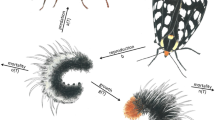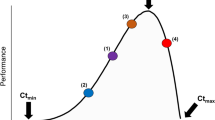Abstract
Studies document the fact that temperature changes strongly affect interactions in many consumer-resource systems through altered, or shifted, phenologies. The mistiming of events, such as migration or emergence times, or the contraction or expansion of development times can upset the normal synchronization and lead to increased or decreased predation events. In this paper, we formulate a continuous time, phenologically-structured model of predator-prey interactions that is driven by temperature variations. It is particularly applicable to arthropod interactions because their development rates are so strongly temperature related. The model takes the form of a system of partial differential-integral equations for the species’ population densities in development-time variables. In special cases, the model is analytically tractable and we find a closed-form solution. By calculating density variations under different temperature regimes, the model gives a quantitative method for assessing the effects of global temperature change on consumer-resource interactions.
Similar content being viewed by others
References
Allen, L.J.S., 2007. An Introduction to Mathematical Biology. Prentice Hall, Upper Saddle River.
Auslander, D.M., Oster, G.F., Huffaker, C.B., 1974. Dynamics of interacting populations. J. Franklin Inst. 297(5), 345–376.
Bazzaz, F.A., 1990. The response of natural ecosystems to rising global CO2 levels. Annu. Rev. Ecol. Syst. 21, 167–196.
Bentz, B.J., Logan, J.A., Amman, G.D., 1991. Temperature dependent development of the mountain pine beetle and simulation of its phenology. Can. Entomol. 123, 1083–1094.
Burns, W., 2000. Bibliography: climate change and its impact on species and ecosystems, www.eelink.net/~asilwildlife/CCWildlife.html.
Buse, A., Good, J.E.G., 1996. Synchronization of larval emergence in winter moth (Operophtera brumata L.) and budburst in pedunculate oak (Quercus robur L.) under simulated climate change. Ecol. Entomol. 21, 335–343.
Coleman, C.S., Frauenthal, J.C., 1983. Satiable egg-eating predators. Math. Biosci. 63, 99–119.
Cushing, J.M., 1998. An Introduction to Age-Structured Population Dynamics, CBMS-NSF Regional Conference Series, vol. 71. SIAM, Philadelphia.
de Roos, A.M., 1997. A gentle introduction to physiologically structured population models. In: Tuljapurkar, S., Caswell, H. (Eds.), Structured-Population Models in Marine, Terrestrial, and Freshwater Systems, pp. 119–204. Chapman & Hall, New York. Chap. 5.
Garvie, M.R., 2007. Finite-difference schemes for reaction-diffusion equations modeling predator-prey interactions in MATLAB. Bull. Math. Biol. 69, 931–956.
Gilbert, E., Powell, J.A., Logan, J.A., Bentz, B.J., 2004. Comparison of three models predicting developmental milestones given environmental and individual variation. Bull. Math. Biol. 66(6), 1821–1850.
Gillooly, J.F., Charnov, E.L., West, G.B., Savage, V.M., Brown, J.M., 2002. Effects of size and temperature on development time. Nature 17, 70–73.
Gurtin, M.E., Levine, D.S., 1979. On predator-prey interaction with predation dependent on prey age. Math. Biosci. 47, 201–219.
Harrington, R., Woiwod, I., Sparks, T., 1999. Climate change and trophic interactions. Trends Evol. Ecol. 14, 146–150.
Hilbert, D.W., Logan, J.A., 1983. Empirical model of nymphal development for the migratory grasshopper M. sanguinipes (Orthoptera: Acrididae). Environ. Entomol. 12, 1–5.
Hill, J.K., Hodkinson, I.D., 1992. Effect of temperature on phenological synchrony and altitudinal distribution of jumping plant lice (Hemiptera: Psylloidea) on dwarf willow (Salix lapponum) in Norway. Ecol. Entomol. 20, 237–244.
Joern, A., Gaines, S.B., 1990. Population dynamics and regulation in grasshoppers. In: Chapman, R.F., Joern, A. (Eds.), Biology of Grasshoppers, pp. 415–482. Wiley, New York. Chap. 14.
Joern, A., Logan, J.D., Wolesensky, W., 2005. Effects of global climate change on agricultural pests: possible impacts and dynamics at population, species interaction, and community levels. In: Lal, R., Stewart, B.A., Uphoff, N., Hansen, D.O. (Eds.), Climate change and global food security, pp. 321–362. CRC Press, Boca Raton. Chap. 13.
Joern, A., Danner, B.J., Logan, J.D., Wolesensky, W., 2006. Natural history of mass-action in predator-prey models: a case study from wolf spiders and grasshoppers. Am. Midlands Nat. 156, 52–64.
Kareiva, P.M., Kingsolver, J.G., Huey, R.B., 1993. Biotic Interactions and Global Change. Sinauer, Sunderland.
Kot, M., 2000. Elements of Mathematical Ecology. Cambridge University Press, Cambridge.
Lactin, D.J., Johnson, R.R., 1998. Environmental, physical, and behavioural determinants of body temperature in grasshopper nymphs (Orthoptera: Acrididae). Can. Entomol. 130, 551–557.
Levine, D.S., 1981. On the stability of a predator-prey system with egg-eating predators. Math. Biosci. 56, 27–46.
Li, D., Jackson, J.J., 1996. How temperature affects development and reproduction in spiders. J. Thermal Biol. 21(4), 245–274.
Logan, J.D., 1994. Introduction to Nonlinear Partial Differential Equations. Wiley–Interscience, New York.
Logan, J.D., 2006. Applied Mathematics, 3rd edn. Wiley–Interscience, New York.
Logan, J.A., Bentz, B.J., 1999. Model analysis of mountain pine beetle seasonality. Environ. Entomol. 28, 924–934.
Logan, J.A., Powell, J.A., 2001. Ghost forests, global warming, and the mountain pine beetle. Am. Entomologist 47(3), 160–172.
Logan, J.D., Wolesensky, W., 2007a. Accounting for temperature in predator functional responses. Nat. Resour. Model., in press.
Logan, J.D., Wolesensky, W., 2007b. An index to measure the effects of temperature change on trophic interactions. J. Theor. Biol. 246, 366–376.
Logan, J.D., Wolesensky, W., Joern, A., 2006. Temperature-dependent phenology and predation in arthropod systems. Ecol. Modell. 196, 471–482.
Logan, J.D., Wolesensky, W., Joern, A., 2007. Insect development under predation risk, variable temperature, and variable food quality. Math. Biosci. Eng. 4(1), 47–65.
Metz, J.A.J., Diekmann, O. (Eds.), 1986. The Dynamics of Physiologically Structured Populations. Springer, Berlin.
Metz, J.A.J., de Roos, A.M., van den Bosch, F., 1988. Population models incorporating physiological structure: a quick survey of the basic concepts and an application to size-structured population dynamics in waterfleas. In: Ebenman, B., Persson, L. (Eds.), Size-structured populations, pp. 106–126. Springer, Berlin.
Powell, J.A., Jenkins, J.L., Logan, J.A., Bentz, B.J., 2000. Seasonal temperature alone can synchronize life cycles. Bull. Math. Biol. 62, 977–998.
Rochat, J., Gutierrez, A.P., 2001. Weather-mediated regulation of olive scale by two parasitoids. J. Animal Ecol. 70, 476–490.
Saleem, M., 1983. Predator-prey relationships: egg-eating predators. Math. Biosci. 65, 187–197.
Saleem, M., 1984. Egg-eating age-structured predators in interaction with age-structured prey. Math. Biosci. 70, 91–104.
Shenk, H.J., 1996. Modeling the effect of temperature on growth and persistence of tree species: a critical review of tree population models. Ecol. Modell. 92, 1–32.
Smith, J.M., 1974. Models in Ecology. Cambridge University Press, Cambridge.
Thompson, R.W., Dibiasio, D., Mendis, C., 1982. Predator-prey interactions: egg-eating predators. Math. Biosci. 60, 109–120.
Visser, M.E., Both, C., 2005. Shifts in phenology due to global climate change: the need for a yardstick. Proc. Roy. Soc. B 272, 2561–2569.
Visser, M.E., Holleman, L.J.M., 2001. Warmer springs disrupt the synchrony of oak and winter moth phenology. Proc. Roy. Soc. B 268, 289–294.
Walther, G.-R., Post, E., Convey, P., Menzel, A., Parmesan, C., Beebee, T.J.C., Fromentin, J.-M., Hoegh-Guldberg, O., Bairlein, F., 2002. Ecological responses to recent climate change. Nature 416, 389–395.
Wermelinger, B., Seifert, M., 1999. Temperature-dependent reproduction of the spruce beetle Ips typographus, and the analysis of potential population growth. Ecol. Entomol. 24, 103–110.
Wolesensky, W., Logan, J.D., 2007. An individual, stochastic model of growth, incorporating state-dependent risk and random foraging and climate. Math. Biosci. Eng. 4(1), 67–84.
Wollkind, D., Logan, J.A., 1978. Temperature-dependent predator-prey mite ecosystem on apple tree foliage. J. Math. Biol. 6, 265–283.
Author information
Authors and Affiliations
Corresponding author
Rights and permissions
About this article
Cite this article
Logan, J.D. Phenologically-Structured Predator-Prey Dynamics with Temperature Dependence. Bull. Math. Biol. 70, 1–20 (2008). https://doi.org/10.1007/s11538-007-9237-6
Received:
Accepted:
Published:
Issue Date:
DOI: https://doi.org/10.1007/s11538-007-9237-6




